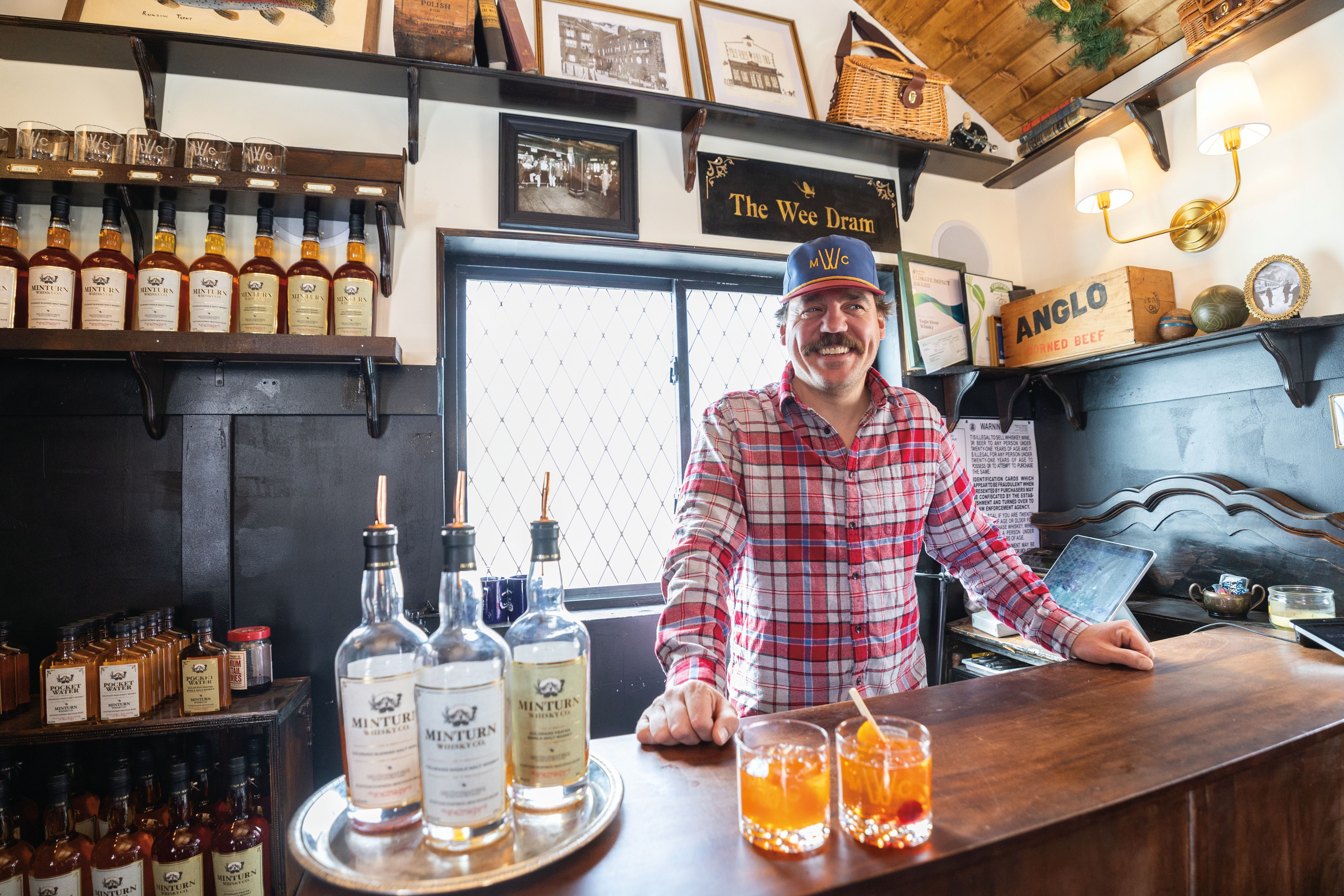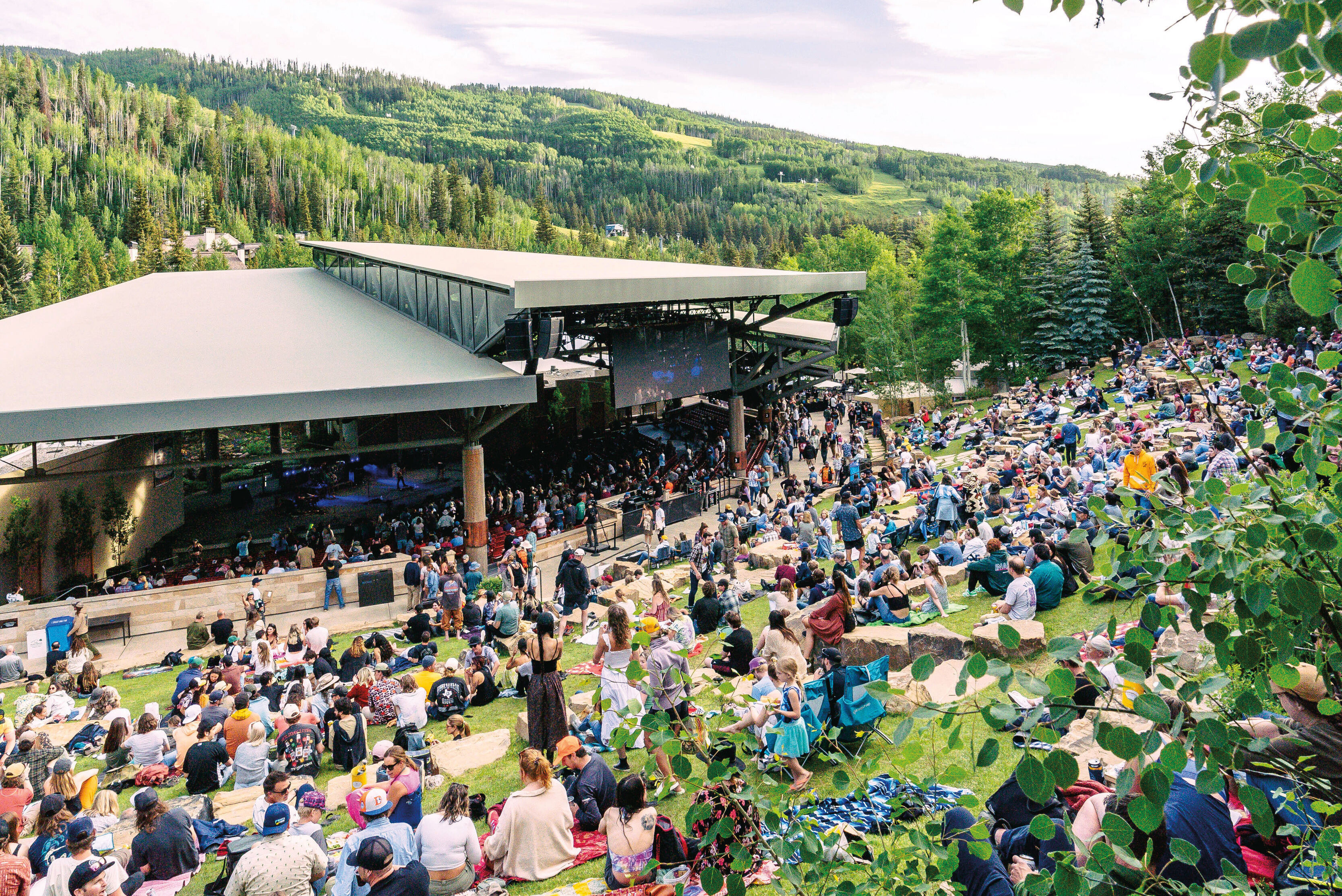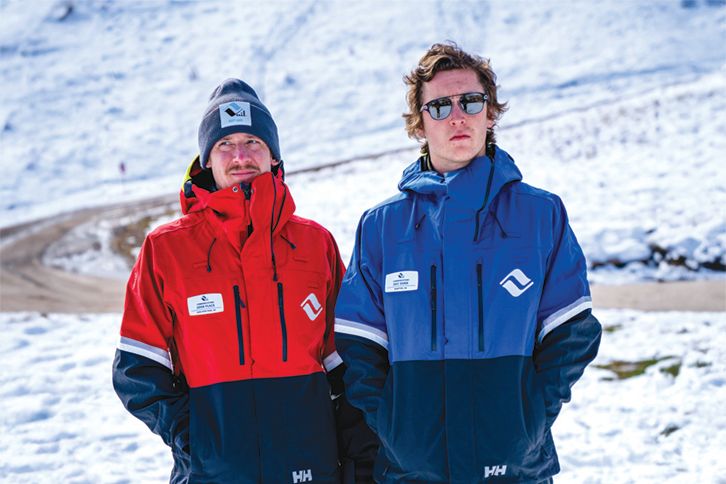Two Vail Athletes Prove That Mogul Skiing Remains Relevant
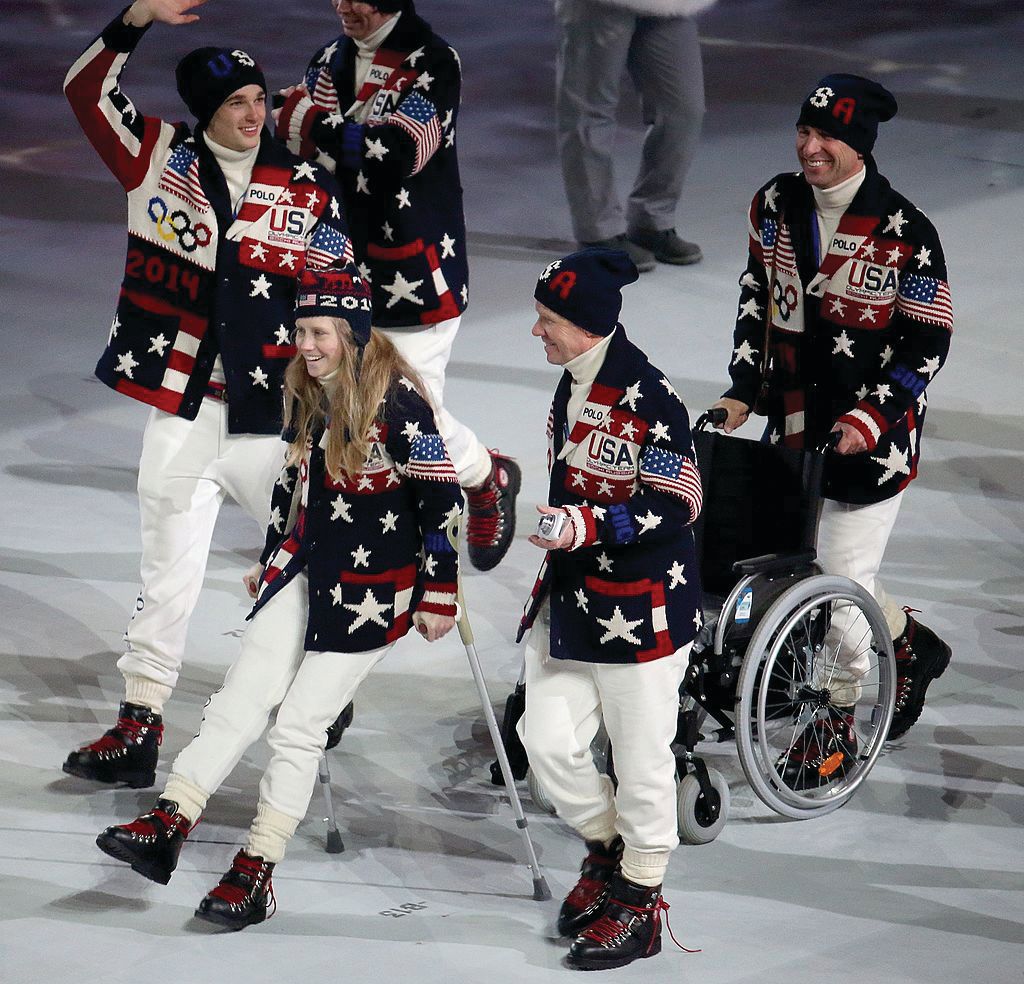
After breaking a leg during a training run at the Sochi 2014 Winter Olympics, Vail Valley moguls skier Heidi Kloser drew thunderous applause as she hobbled on crutches flanked by U.S. Ski Team athletes during the opening ceremony of a Games she would never ski.
Image: Getty Images
Thunderclouds are stirring the air above Bald Eagle Lake in Steamboat Springs, where mogul skier Heidi Kloser is warming up on one of three shoreside trampolines. These are no backyard toys. They’re part of an advanced outdoor training facility that also includes a 40-foot-high wooden ski jump carpeted with slippery synthetic Snowflex that lets skiers soar off kickers into the safety of the lake. And 24-year-old Kloser is obviously no amateur. Each bounce on the tramp launches her so high that gravity seems reluctant to recall her, letting her float instead in happy weightlessness before reeling her back to earth. With each fall, she snaps her body into acrobatic swirls and tucks that mark her as a pro.
Yet here she is on this July afternoon, training with the much younger aspirants of Ski and Snowboard Club Vail (SSCV), taking direction from head moguls coach Riley Campbell. After disappointing performances last winter, Kloser lost her berth on the U.S. Ski Team and found herself back in the farm league. But she’s determined to rise again, and to pursue the Olympic dream that eluded her so cruelly at Sochi.
Back in 2010, when Kloser was named World Cup Rookie of the Year, no one would’ve predicted her future as an underdog. She was notching podium finishes in moguls and dual moguls, and ranked among the few female competitors capable of performing the two hardest jumps: the back full (a backflip with a full twist) and the cork 7 (an off-axis, 720-degree spin).
Her athletic pedigree also pointed toward big-league success. Mike Kloser, Heidi’s dad, competed in moguls before becoming a world champion mountain biker; her mom, Emily Kloser, won the inaugural Trans-Rockies Run (a five-day, 110-mile running race through some of Colorado’s most rugged terrain). From them, Heidi inherited an almost superhuman aerobic capacity, so that the fitness tests she logged while on the U.S. Ski Team indicated she was better suited to Nordic skiing than explosive, sprint-like mogul runs.
But by age three, Heidi was already gravitating toward the mogul fields that her dad had mastered (after competing, Mike operated the World Pro Mogul tour in the 1980s). “Even when I was still skiing with a harness, I would pull my mom into the moguls,” says Kloser. “It’s just where I seemed to want to go.” Soon, the pint-size prodigy was shredding the bumps below Chair 11 and reveling in the incredulous hoots from lift-riders who watched Kloser’s tiny frame go where they didn’t dare.
By 2014, when she arrived in Sochi for her first Olympic Games, Kloser ranked fourth in the world (second on the U.S. team, behind Hannah Kearney) and was gunning for a medal. Instead, she crashed during a training run, breaking her femur and tearing ligaments in her right knee. When the TV cameras swooped in, it was to document her disappointment, not her anticipated triumph. Yet even in defeat, Kloser gave viewers an inspiring show: Instead of skulking home to mope, she paraded into the opening ceremonies on crutches. Then Liberty Mutual Insurance launched Kloser into the limelight by featuring her indomitable spirit in a commercial it aired a few days later. “It’s a challenging time, but when I make it to the next Olympics, it will all mean so much more,” Kloser said during the spot, entitled “Rise.”
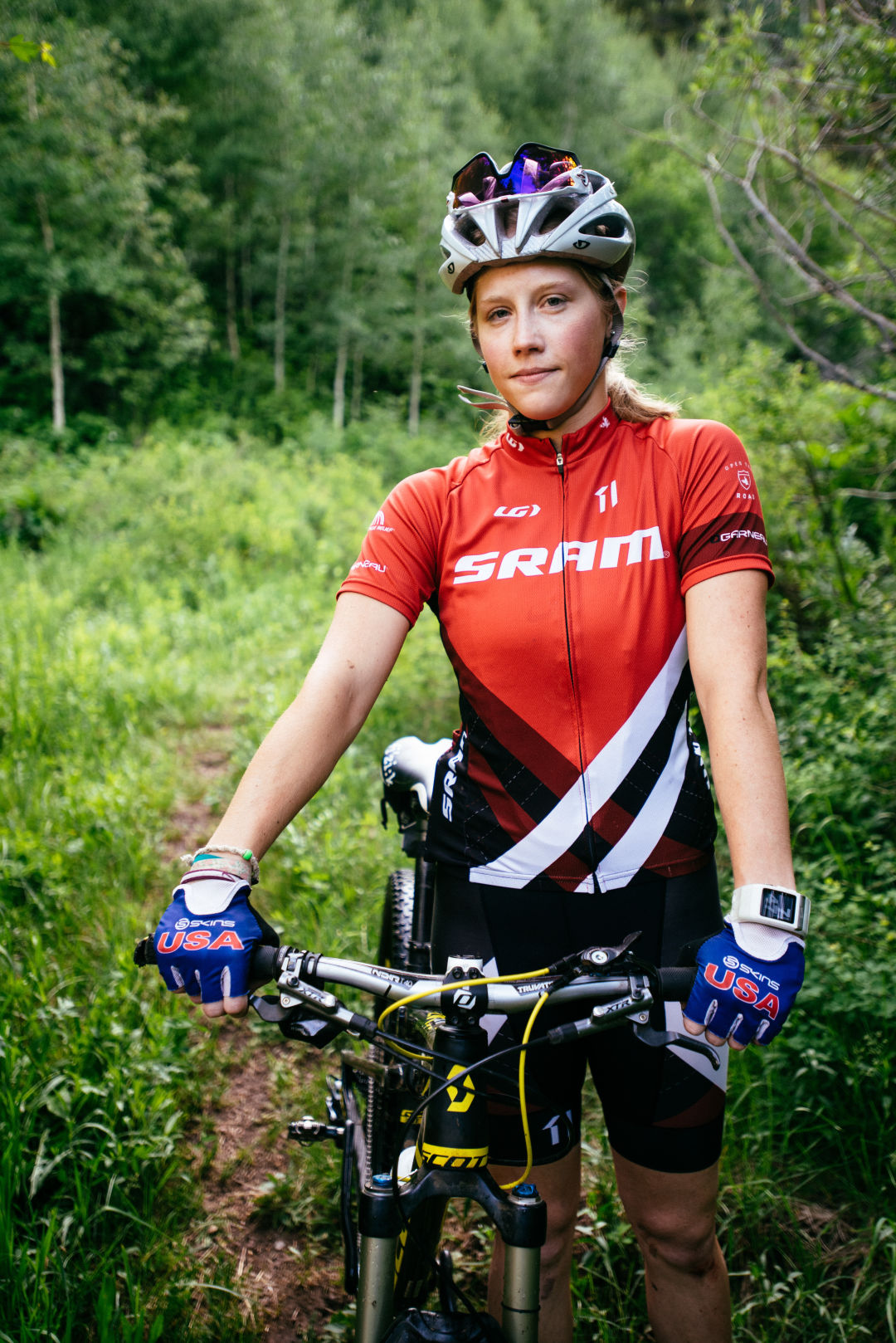
Kloser earlier this summer while cross-training on singletrack near her home in Vail.
Image: Ryan Dearth
Kloser maintains that competing would’ve meant more to her than the celebrity she enjoyed after her crash. “But it was really cool to be a part of reminding people why we do sports,” she says of the commercial. “And sometimes, you just have to take what you’re given and put a smile on your face.”
But as Kloser staged her comeback, staffing changes on the U.S. Ski Team left her feeling adrift. “The new coaches emphasized quantity over quality,” says Kloser, explaining that throughout the high-repetition training, she’d gotten into the habit of landing some of her twisting tricks with too much weight on her right foot. Last October in Switzerland, she sustained an injury that wasn’t diagnosed until May 2016, when William Sterett, her Vail Valley orthopedic surgeon, declared she’d re-fractured her femur and also fractured her tibeal plateau. The injury explained a lot about Kloser’s lackluster races, but it didn’t make the ski team reconsider its decision to cut her.
“She’s back in the hopper just like everybody else and has to prove herself again,” says SSCV coach Campbell. “But if I do my job, I won’t be working with her for very long.”
Kloser received Sterett’s approval to resume her training in July (two months after she typically would’ve started an off-season regimen), with the goal of placing so well in this winter’s North American races that she’ll gain admission to the World Cup circuit—and qualify for the 2018 Olympic Winter Games in Pyeongchang.
“I think she has the potential to do it,” says Matt Gnoza, head moguls coach for the U.S. Freestyle Ski Team. Kloser wouldn’t be the first to earn back a spot on the national team—Patrick “The Rocket” Deneen staged a similar comeback in 2007 and subsequently competed in two Olympic Games—but it’s a long shot. Getting to Pyeongchang will require every bit of Kloser’s now-famous fortitude. Says Gnoza, “It would be a movie in the making.”
Over the years, Vail has produced an impressive cadre of moguls skiers, including Kristi Waring and Toby Dawson (a 2013 inductee in the U.S. Ski & Snowboard Hall of Fame). But it wasn’t until 2012, when moguls coach John Dowling signed on with the SSCV, that Vail became one of the biggest bumps incubators in North America.
Dogmatic but undeniably effective, Dowling is the most successful regional coach in moguls history, having helped some 25 athletes earn spots on the U.S. team—more than anyone else. “Now kids I’ve trained are becoming coaches and developing new skiers, so it’s getting hard to tally just who I can take credit for,” says the 52-year-old. That achievement resulted, in part, from his rigorous analysis of mogul technique: By studying competitors’ various styles and sketching out proper form, Dowling created teaching guidelines for a sport that had always shot from the hip.
“When moguls first started, it was a talent show,” recalls Dowling. Those were the “hotdogging” years of the 1960s and ‘70s, when skiers vied not only to be the fastest down the bump run, but also to impress onlookers with their swagger and derring-do. Later, dedicated jump ramps became a standard feature in moguls competition, but initially, skiers inserted jumps and aerial stunts into their runs wherever the terrain and inspiration dictated. Moguls became the proving ground for every resort’s top skiers: All the cool kids were bumpers and jumpers. Dowling was one of those.
Growing up near Sugarloaf ski area in Maine, Dowling was into hotdogging and ski ballet (performing gymnastic-style pirouettes and leaps while on skis). He competed for the U.S. at the junior world championships. Then, at age 19, he got a part-time job as a moguls coach at Maine’s Carrabassett Academy, which led to an eight-year run coaching Team Breckenridge, then a season coaching the Canadian national team at the 1999/2000 FIS Freestyle Skiing World Cup. There, however, the Dartmouth grad (with a bachelor’s degree in Latin) struggled to make an impact. “I was working with a group of really veteran athletes, and everyone was already set in their ways,” he explains.
So in 2001 Dowling rededicated himself to coaching on the regional level, signing on with Team Summit in Breckenridge, where his effect on developing skiers was transformative. He taught the likes of Jeremy Bloom, Toby Dawson, and Alex Wilson. But after eight years at Team Summit, then another two seasons with Team Breck, Dowling (and Riley Campbell, who studied under Dowling as a competitor before coaching alongside him at Team Summit) left for Ski Club Vail. After a decade of struggling in vain to find the money and infrastructure required to build a world-class program, in Vail, Dowling says, he finally found “more resources.”

Kloser’s land training regimen involves hours of pumping iron at the Minturn Fitness Center.
Image: Ryan Dearth
That’s what it takes these days to produce top hotdoggers. What was once a “talent show” went legit in 1979, when the International Ski Federation recognized the sport of Freestyle (comprising the three disciplines of moguls, aerials, and ski ballet) and developed judging protocols for competition. The 1988 Olympics at Calgary welcomed Freestyle as a demonstration sport. Moguls became a medal event four years later at Albertville. Aerials won Olympic inclusion in 1994, at Lillehammer. Unsurprisingly, ski ballet went the way of disco.
But official acceptance took some vitality out of the sport, says Dowling. “The scoring system is focused more on deductions than rewarding stylistic differences,” he explains. That cultivates a tendency among athletes to ski conservatively, focusing on avoiding mistakes rather than exploring their potential. Now, says Campbell, “Precision has taken over where there used to be machismo.”
Dowling wants to keep moguls, like the lost sport of ski ballet, from sinking into irrelevancy.
“There was a time, before freeride, when freestyle was the craziest thing that was happening on the hill,” he recalls. Hoping to rekindle that excitement, Dowling staged the Vail Pro Mogul event last January.
Offering pros a $5,000 cash prize—and up to $1,500 for amateurs—the competition brought everyone from aging hotdoggers to today’s reigning champion, Canadian Mikaël Kingsbury, to Vail’s Cookshack course. The judges included 2015 FIS Rookie of the Year Morgan Schild, a Dowling protégé. And to encourage competitors to go all out, rather than hedge their bets, style points counted in the final scores; judges were allowed a measure of subjectivity. SSCV mogulist Casey Andringa won the men’s pro contest. Heidi Kloser led the women. And Kingsbury finished fifth. “He had too much on the line to really go for it in an event that didn’t award FIS points,” says Campbell. And, adds Dowling, that jumping emphasis has also made the sport more exclusive. Kids can’t stay competitive without water jump training in the summer, and there are only four such facilities in the U.S. (Bald Eagle Lake, the only venue in Colorado, is a two-hour drive from Vail). “By age 14 or 15, kids must make a big lifestyle change by moving to one of those training centers, or else they won’t be able to stay in the sport,” says Dowling. Moguls has become like gymnastics, which winnows most of its participants by their early teens.But the event injected some fun into a sport that, according to its skiers and spectators, has started to seem straightjacketed. Amping up the aerials component could offer a solution. “Slopestyle really took the limelight,” admits Campbell, noting that moguls has given chase by placing more importance on jump training.
Campbell draws another comparison: “We’ve become one of those sports, like gymnastics, that people only pay attention to once every four years, during the Olympics.” And in between those Games? Kids are lining up to shred the terrain park or ski extreme terrain out-of-bounds. But at any given ski area, the mogul runs are looking emptier than ever.
It's a cloudless morning in June, and 16-year-old Tess Johnson is enjoying a few summer days at home in Edwards. Ever since she made the U.S. Ski Team—becoming, at 14, the youngest mogul skier ever to be invited onto the national squad—she’s logged a lot of travel. This summer, the Vail Ski and Snowboard Academy senior bounced between training sessions in Park City, Whistler, and Australia. And her bedroom evidences the spoils of such dedication.
Strings of medals hang from the wrought-iron bedpost. “This is my Junior World silver medal from Sweden this year,” says Johnson. “And these are a couple of NorAm podium medals.” On the opposite wall there’s a meticulously arranged display of her race bibs, competitor’s passes, and team snapshots (when she’s not consumed with ski racing, Johnson is a crackerjack soccer player for Vail Mountain School). All are mementos from the 2015–2016 ski season, in which she not only took second in world competition, but also won the North American Grand Prix title. She’s giving herself a few more weeks to savor last year’s awards. Then she’ll hide them in storage.”
“It’s a mental thing, really. I put the medals from past seasons away and make a clean start,” says Johnson, who hopes to redecorate her bedpost with World Cup medals this winter.
Not that racing on the NorAm circuit would be ho-hum. After all, the world’s best mogul skiers hail from the U.S. and Canada. But after winning the NorAm title last winter, Johnson feels eager for a fresh proving ground—and she aspires to parlay World Cup performances into a spot on the next Olympic team. Says Johnson blithely, “I want to win a gold in 2018.”
Johnson will have to wait until this winter’s racing begins to learn whether she’ll be competing on the world circuit. But, Gnoza says, there’s a very good chance that she’ll be seeing World Cup starts. “Moguls is a very technical sport, and we see a very strong technical skiing foundation in [Johnson]. That, along with her athleticism, allows her to push the limits and gives her the advantage over most competitors her age.”
Even Johnson admits that if she hadn’t found moguls, she probably would have seized upon some other sport. “By nature, I’m competitive and athletic,” she explains. With a ski patroller/raft guide dad and a competitive mom who had been a nationally ranked junior tennis player, it’s not surprising that she started skiing as a toddler—and dazzled onlookers with her ability to make carved turns by age three. No one had taught her. She’d just figured it out.
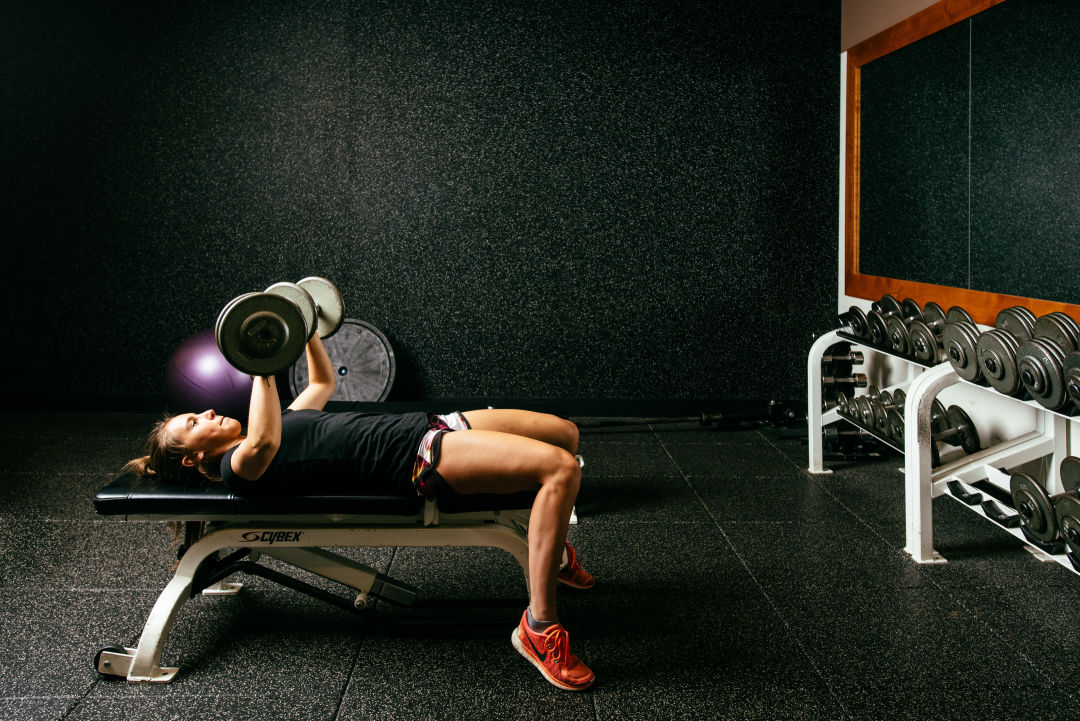
Tess Johnson’s home gym is the Homestead Country Club in Edwards.
Image: Ryan Dearth
But Tess also credits John Dowling and Riley Campbell for honing her natural ability. During Dowling’s first year with the SSCV, says Johnson, “We spent an entire year reforming my turn.” She rolls her eyes, remembering the painstaking work of replacing old habits with new ones. But she places utter trust in Dowling, and believes in the end result: that by skiing taller, with hips projected forward instead of locked in a crouch, she’ll ski faster. “More aggressively,” she says, eyes glinting. “Like the guys.”
So yes, the topic of competition has a way of unveiling an edgy side to this otherwise doe-eyed teen. But Johnson’s steely drive to win coexists with a pliant ability to learn and apply new ski techniques. And that coachability may be the thing that puts her on the path to Olympic gold. After all, there’s plenty of talent around the world. But not every competitor can set ego aside long enough to take direction, even from gurus.
“It’s one of my strengths,” Johnson acknowledges matter-of-factly. “Riley sometimes tells me, ‘I love coaching you because when I tell you to do something, you do it!’”
For now, she’s working on her jumps. Whereas Kloser is famous for being a daring aerialist, Johnson specializes in speed. So this summer in Park City, she’s using her water ramp time to perfect a backflip with a full twist, hoping that she can progress with it to the point that it’s ready for on-snow exhibition this winter.
And if not? That’s OK. Johnson is cool-headed enough to know when to dial down the pressure. “The passion is what got me here,” she says. “When I get caught up in results, that’s when I realize I need to step back, remove myself from the outcome, and just focus on the process.” In doing so, she defuses anxiety and puts her energy into the things that are most likely to achieve her goals—like basic training. “It’s easy to get caught up in the [ski team] politics and the World Cup starts,” says Johnson, “But I definitely ski better when I step back and focus on my skiing.”
She does, however, take the time to watch old competition reels, which depict a very different kind of mogul skiing than the contemporary version she’s mastered. “[Those skiers] just kinda bounced around,” says Johnson. “Not a lot of them even did 360s (upright spins).” But when she considers the throngs of fans lining the courses, and how high the energy level was, she pauses.
“I think it’s kind of a dying sport, which is a little sad,” she says, an unsettling comment coming from someone who is so young, and in the early stages of her career as a moguls pro.
“Everyone I ride lifts with asks me what I do, and they say, ‘Oh! Moguls! We stay away from that.’ But it’s OK,” she explains.”
Moguls may be the middle child between the firstborn that is alpine downhill and the enfant terrible of slopestyle, yet it suits her. She likes skiing what everyone else avoids. She loves chasing her coaches, trying to keep up with them. That’s when she becomes part of an elite minority that seeks perfection in places that most skiers find too ego-bruising to even attempt. She can ski anything, anywhere on the resort. There is nowhere she can’t go. Maybe even South Korea in 2018.
There was a time when Heidi Kloser saw the moguls world that way, too. In 2010, when she was named the World Cup Rookie of the Year, it seemed as if hard work could produce anything she wanted—even recovery from injury. That was until the setbacks started stacking up. Now, the girl who manned up so impressively after disaster is discovering what it’s like to feel cowed.
Standing atop the ramp that will launch her into Bald Eagle Lake, Kloser looks clenched and rigid, and her flight off the jump’s lip seems tentative. Returning from injury isn’t easy, even for the pros. But subsequent attempts bring glimpses of buoyancy, until finally, on her sixth and final leap, she flies into the air with confident competency.
“That one was real good. You could write poetry about that one,” Campbell shouts to Kloser as she dog-paddles to shore.
“Yeah,” she says, heartened to say hello to her long-lost mojo. “That shoulda been on snow.”
And the winner is...Judging alpine downhill racing is easy: The fastest time wins. But deciding who wins a moguls event is considerably more complicated. Racers receive combined scores based on their turns (60%), jumps (20%), and speed (20%), so they can’t sacrifice one element for another: A skier who scrubs speed to launch a fabulous jump may end up losing points—and fancy aerials can’t compensate for sloppy, wide-kneed turns.

Johnson cross-trains on Nottingham Lake with a view of Beaver Creek’s Centennial run.
Image: Ryan Dearth
Q+A with Tess Johnson
May 25, 5:30 to 7:30 p.m., The Inn at the Riverwalk, Edwards
The valley’s own Olympic mogul phenom, Tess Johnson, heads to the Inn at the Riverwalk for a meet and greet with fans, where she’ll also answer questions and sign autographs. innatriverwalk.com








